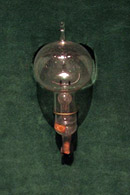What are they?
The incandescent light bulb or lamp is a source of electric light that works by incandescence,
which is the emission of light caused by heating the filament. They are made in an extremely wide
range of sizes, wattages, and voltages.
Where did they come from?

Incandescent bulbs are the original form of electric lighting and have been in use for over 100 years.
While Thomas Edison is widely considered to be the inventor of the incandescent bulb, there are a number of
people who invented components and prototypes of the light bulb well before Edison did.
One of those people
was British physicist Joseph Wilson Swan, who actually received the first patent for a complete incandescent
light bulb with a carbon filament in 1879.
Swan’s house was the first in the world to be lit by a light bulb.
Edison and Swan merged their companies and together they were the first to design a bulb that was commercially viable.
How do they work?
An incandescent bulb typically consists of a glass enclosure containing a tungsten filament. An electric current passes through the filament, heating it to a temperature that produces light.
Incandescent light bulbs usually contain a stem or glass mount attached to the bulb's base which allows the electrical contacts to run through the envelope without gas/air leaks. Small wires embedded in the stem support the filament and/or its lead wires.
The enclosing glass enclosure contains either a vacuum or an inert gas to preserve and protect the filament from evaporating.

Diagram showing the major parts of a modern incandescent light bulb.
- Glass bulb
- Inert gas
- Tungsten filament
- Contact wire (goes to foot)
- Contact wire (goes to base)
- Support wires
- Glass mount/support
- Base contact wire
- Screw threads
- Insulation
- Electrical foot contact
Where are they used?
Incandescent bulbs require no external regulating equipment, have a very low manufacturing cost, and work well on either alternating current or direct current. They are also compatible with control devices such as dimmers, timers, and photo sensors, and can be used both indoors and outdoors. As a result, the incandescent lamp is widely used both in household and commercial lighting, for portable lighting such as table lamps, car headlamps, and flashlights, and for decorative and advertising lighting.
Many incandescent bulbs are scheduled to be phased out of production by 2014. Click here to learn more about the Energy Independence and Security Act of 2007 and how it might affect you.
Other Helpful Resources